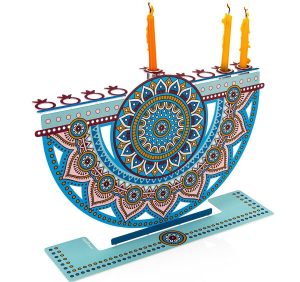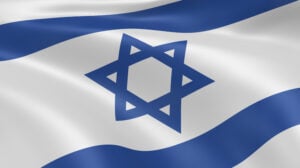Why do we light a menorah during Hanukkah?

The Hanukkah menorah symbolizes the miracle that occurred when the Maccabees, Jewish fighters in ancient Judea in the 2nd century BCE, re-sanctified the Holy Temple in Jerusalem after defeating their Greek-Seleucid occupiers who had desecrated the Temple and banned Jewish worship. Upon taking back control of the Temple, the Maccabees discovered only one kosher jug of olive oil that could be used for lighting the Temple’s Menorah, which was necessary for rededicating the worship space. Even though this was only meant to last one day, a miracle occurred and it lasted for eight days, just in time for more kosher olive oil to be procured.
In celebration of this miracle as well as the rededication of the Temple and the return of Jewish freedom and ritual life, the holiday of Hanukkah (which literally means “dedication”) was established. The central ritual is to light a menorah for eight nights to commemorate and publicize the miracle of the oil that lasted for eight nights, and it’s a tradition that’s been carried on till this day!
- Honor Hanukkah’s Temple origins with our top 10 Second Temple gifts, and read more about Temple history here.

What do we light a menorah with?

The menorah in the Holy Temple used oil, and some people still prefer this traditional option and light wicks inside small glass cups filled with oil that are placed in each candleholder. However, most Hanukkah menorahs today are lit with wax candles, and this is often an easier and more cost-effective option. Either way is perfectly fine depending on your personal preference!
As for the lighting itself, both matches and electric lighters are acceptable. Some people also find it more comfortable to hold the shamash candle in a special holder.
- Read our candles guide to learn more about Hanukkah candles and oil from the Land of Israel
- Check out our oil menorahs
- …And our candle menorahs too!

What order do we light the candles in?

The candles or oil cups are placed inside a menorah from right to left as facing you (an easy way to remember this is that Hebrew is written from right to left!), so that on the first night, we use the rightmost candleholder, then add additional candles to the left as the holiday goes on. However, we light them from left to right, so that the newest candle is always lit first.
You light the shamash (attendant or helper) candle first, recite the appropriate blessings (for your convenience, all the menorahs in our store come with a songs and blessings pamphlet in both Hebrew and English) and then use the shamash to light the remaining candles, starting with the leftmost, before placing it in its candleholder.

When do we light?
Traditionally, a Hanukkah menorah should be lit after nightfall and should last for at least a half hour. The exception is shabbat, when traditional observance dictates that candles are lit before sundown – so if you’re using wax candles, they should be tall enough to last about 1 1/2 hours and stay lit well after nightfall.
The idea is for the lights to be visible at night while there are people in the street to see them – so we can publicize the miracle! – and the candles should burn for at least a half hour after nightfall.

Do I have to light it every night? What if I skip one night?

The ritual is to light Hanukkah candles every night, increasing the number of candles each night.
But don’t worry if you end up skipping one – you can still get back into it the following night! Just make sure you are adding the appropriate number of candles (if you skip night four for example, you still light five the following night).
Where should I put my Hanukkah menorah?
Since the traditional purpose of lighting a menorah is to publicize the miracle of Hanukkah, it’s customary to put one’s Hanukkah menorah on a windowsill where other people outside your home will see it. Another option is to place it near a doorway or on a table in another central, frequently trafficked area of the house. In Israel, some people place a menorah outside near their front door or gate, enclosed in a special glass box to protect the flames.

Can I light more than one menorah? Does each person light their own?
You should have at least one Hanukkah menorah for your home in order to fulfill the commandments of Hanukkah, but there’s nothing against lighting more than one. Some families light just one for the entire household, while others have a custom in which every member of the family lights their own menorah for a personal and individualized connection to the miracle of the Festival of Lights. And many children enjoy lighting their very own!
- See our fun and festive children’s menorahs made especially for your young loved ones
Each person can say their own blessing over their own Hanukkah menorah, but if you are lighting more than one for yourself, just say the blessings over the first one.

What do you do after lighting the menorah on Hanukkah?
Some people sing traditional Hanukkah songs like Maoz Tzur (included in our Hanukkah blessing pamphlet with every menorah purchase!), play games like dreidel with their families, exchange gifts or give sweet treats like gelt chocolate coins, or eat foods fried in oil as another reminder of the miracle of the oil in the Temple.
Whatever your traditions, you should enjoy your Hanukkah lights and the beauty of your menorah!
- See our post about Hanukkah traditions and their origins
- …and our Hanukkah essentials buying guide for everything you’ll need
- Read about foods traditionally eaten on Hanukkah
- Check out our guide to games to play with the whole family after lighting your Hanukkah menorah
How do I choose the right Hanukkah menorah or menorahs for me?

Since menorahs can be made from many different materials, and because it’s such an individual, personal ritual that’s done at home, many options and styles exist, for all budgets and preferences. You should choose one you like, that will bring you joy to the holiday and help you relish the Hanukkah lights.
It’s considered important to beautify the holiday and the mitzvah (commandment) of kindling the Hanukkah lights, and therefore many families will try to purchase the most beautiful one they can afford, and it can become a timeless piece of Judaica passed on from generation to generation. On the other hand, it doesn’t have to be made out of precious metals, and simple, affordable menorahs are also plentiful and perfectly fine.











